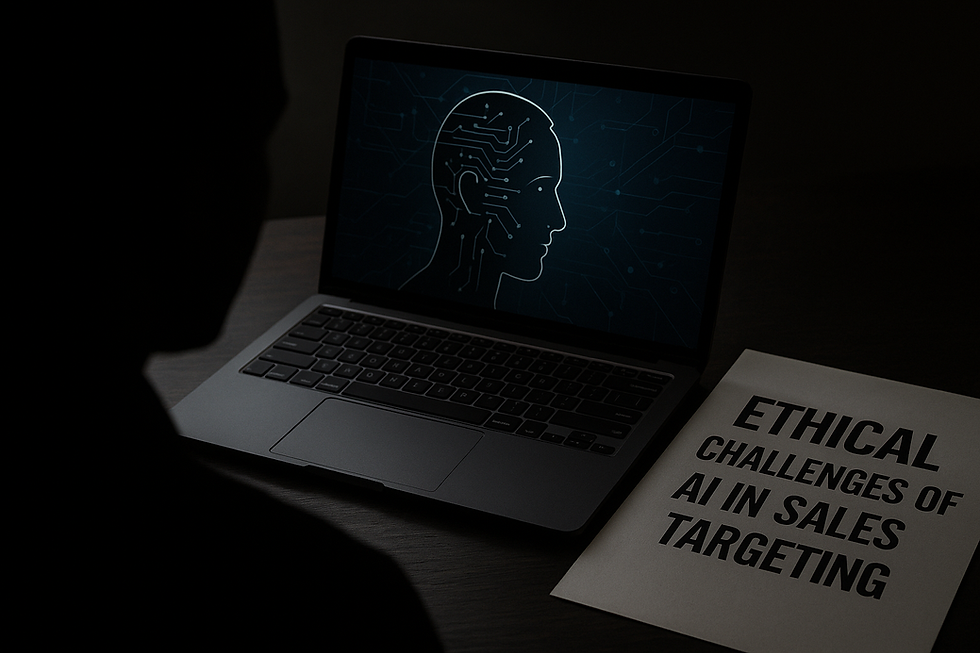A Complete Guide to AI Sales GDPR & CCPA Compliance
- Muiz As-Siddeeqi

- Aug 19
- 6 min read

A Complete Guide to AI Sales GDPR & CCPA Compliance
It’s not just about data anymore.
It’s about trust.
It’s about survival.
And in the world of AI-powered sales—where every click, scroll, and pause is recorded, processed, predicted, and monetized—trust is everything.
We’re no longer just talking about email open rates or retargeting ads. We’re talking about machines making micro-decisions based on personal behaviors. We’re talking about algorithms predicting our buying intent before we even realize we’re in the mood to buy.
But what happens when those machines cross the line?
What happens when AI in sales goes too far?
The answer isn't just legal — it's existential. Welcome to the frontline of AI Sales GDPR and CCPA Compliance. This isn’t a guide you read once and forget. This is the kind you hold onto like a map through a data privacy minefield.
Let’s dive deep.
Bonus: Machine Learning in Sales: The Ultimate Guide to Transforming Revenue with Real-Time Intelligence
Why This Compliance Guide Matters Now More Than Ever
AI is taking over the sales process—and not slowly. According to Salesforce’s State of Sales Report (2024), 57% of high-performing sales teams are now using AI to guide decisions, automate tasks, and predict customer behavior. But here’s what they don’t always mention: compliance is trailing behind.
A 2023 survey by Cisco found that:
92% of consumers say they care about data privacy.
81% would walk away from a brand that doesn’t protect their personal data.
Only 23% of companies felt "fully prepared" to comply with regulations like GDPR and CCPA when integrating AI into their sales models.
This is not a gap. It’s a legal and reputational black hole.
What Exactly Is at Stake?
Let’s not sugarcoat this.
Hefty fines: In 2023, Meta was fined €1.2 billion by the Irish Data Protection Commission for violating GDPR rules.
Loss of customer trust: After the Cambridge Analytica scandal, Facebook's brand trust fell by 66% according to Reuters/Ipsos.
Lawsuits and class actions: In 2022, Sephora faced a $1.2 million settlement under CCPA violations for sharing customer data with advertising networks.
And guess what? These weren't because of malice. These were because of data handling errors, AI overreach, and negligence in compliance implementation.
AI in Sales: Where the Data Risk Actually Begins
AI doesn't just act. It learns. And in doing so, it collects, stores, and analyzes sensitive data at scale.
Here are just a few ways your AI sales engine might already be breaching compliance — without you even knowing:
Predictive lead scoring models collecting inferred demographic data (age, income, ethnicity).
Sales chatbots capturing user data and storing it in non-compliant formats.
Email automation tools tracking user behavior without proper consent.
CRM enrichment tools scraping third-party databases, mixing verified and unverifiable data.
Behavioral analytics platforms that don’t provide opt-outs, and silently profile users.
Let’s be brutally honest: these tools are powerful—but they’re also dangerous if not governed properly.
What the Law Actually Says (GDPR and CCPA Demystified)
GDPR: The European Backbone of Privacy (Since 2018)
Applies to: All companies handling data of EU residents, regardless of company location.
Key Rights:
Right to Access
Right to be Forgotten
Right to Data Portability
Right to Restrict Processing
Right to Object
Right to Human Explanation (for automated decisions)
➡ Real clause to note: Article 22(1) prohibits decisions made solely on automated processing (including profiling) that produce legal or significant effects.
This directly impacts AI-powered sales scoring tools that automatically approve, reject, or prioritize leads.
CCPA: California’s Data Constitution (Since 2020)
Applies to: Businesses that collect personal data of California residents and meet one of the following:
$25M+ in annual gross revenue
50,000+ consumers' data collected annually
Derives 50% or more of revenue from selling personal data
Key Rights:
Right to Know
Right to Delete
Right to Opt-Out of Data Sale
Right to Non-Discrimination for exercising privacy rights
➡ Real clause to watch: Section 1798.100(c) says businesses must notify consumers about what categories of personal data they collect, and for what purpose, at the time of collection.
This directly impacts AI sales tools that collect behavioral data silently in the background.
Where Most Sales Teams Go Wrong (And Don’t Even Realize It)
Even experienced sales ops professionals fall into these documented compliance traps:
Using AI-driven CRM enrichment tools without verifying data sources.
Implementing lead prioritization engines without obtaining prior consent.
Running A/B tests that change pricing dynamically — potentially breaching fairness laws.
Collecting web tracking data without full cookie consent in the EU.
Ignoring the "right to explanation" when AI models reject a customer lead.
According to Deloitte’s 2024 Privacy Tech Benchmark, over 71% of mid-sized SaaS companies using AI-based personalization tools were non-compliant with at least one GDPR/CCPA requirement.
Documented Case Studies: What Went Wrong (and Why)
Case Study 1: Clearview AI – The Poster Child of GDPR Violations
Clearview scraped billions of images from the web for AI facial recognition. In 2022, Italy, UK, France, Austria, and Greece all fined or banned the company for lack of consent, lack of explainability, and non-compliance with data rights.
This had zero to do with AI’s capability—and everything to do with ignoring GDPR obligations.
Case Study 2: Sephora (2022) – CCPA Non-Compliance with Targeting Data
Sephora was fined $1.2 million for not disclosing to users that it was selling behavioral data (via third-party trackers), not offering an opt-out, and failing to process “Do Not Sell My Info” requests.
This wasn’t a technical failure. It was a failure to implement sales AI in a compliant way.
Case Study 3: Meta (Facebook) – €1.2 Billion GDPR Fine
The Irish Data Protection Commission’s decision in 2023 made headlines globally. Meta was transferring EU user data to the US for AI targeting—without adequate legal safeguards.
They were using machine learning to improve ad delivery, but the entire data pipe was non-compliant with EU-to-US transfer rules.
Real-World Compliance Checklist for AI in Sales
Here’s your no-nonsense checklist to stay on the right side of the law:
Audit Your Data Flows: Where is the data coming from? Where is it going? Who can access it?
Document Data Processing Logic: Especially for AI-driven scoring, predictions, personalization, and targeting.
Implement Consent Mechanisms: Especially for cookie tracking, email personalization, predictive profiling.
Use Transparent Language: Privacy policies must clearly explain AI usage — no legalese.
Enable Right to Access and Delete: Build systems that can quickly comply with such requests.
Keep a Record of Processing Activities (ROPA): Mandatory under GDPR Article 30.
Test for Discrimination: Run fairness audits on AI models to avoid biases, which could trigger lawsuits.
Train Your Sales & RevOps Teams: This is not just legal’s job. Every stakeholder must understand the basics.
Unique But Mandatory: AI-Specific Compliance Measures You Can't Ignore
Let’s go deeper. These measures are almost never discussed, but they’re mandatory for AI-based sales systems:
Algorithmic Impact Assessments (AIA): Required under Canada’s proposed Artificial Intelligence and Data Act (AIDA) and recommended by EU AI Act. Expect this globally soon.
Explainability Layers in Your CRM: Especially if your CRM uses AI to rank or discard leads. This is required by GDPR Article 22.
Model Retraining Governance Logs: Every AI update or model tuning that uses personal data must be logged, documented, and evaluated.
Data Minimization Checks: Don’t hoard customer data for AI training “just in case.” That’s explicitly against GDPR Article 5.
Building Privacy by Design into Your AI Sales Tools
“Privacy by Design” is no longer optional. Under GDPR Article 25 and the CCPA regulations, it’s the default expectation.
Here’s how to build it right into your tech stack:
Use data masking and pseudonymization during AI model training.
Integrate privacy impact assessments (PIAs) into every new AI project kickoff.
Build automatic purge systems for inactive lead data.
Offer dynamic consent dashboards where users can control data usage.
Set up multi-layer permissions between sales teams and backend data stores.
Why Sales AI Vendors Need Scrutiny (You’re Liable Too)
Using a tool like Apollo.io, ZoomInfo, Drift, Gong, Salesforce Einstein, or Outreach.io?
Then you must ask:
Where is their data stored?
Do they offer Data Processing Agreements (DPAs)?
Is their algorithmic profiling explainable?
Can they process data subject access requests (DSARs)?
Are they SOC 2 / ISO 27001 / GDPR-compliant?
If the answer is “we don’t know”—you are legally liable.
Conclusion: This Is Bigger Than Sales. It’s About Surviving the AI Era.
Every lead you score.
Every pitch you automate.
Every user journey you personalize.
It’s not just a transaction anymore. It’s a decision that lives in a regulated space.
GDPR and CCPA are not obstacles. They’re guardrails. And those who ignore them aren’t just risking lawsuits—they’re risking extinction.
The best sales teams in 2025 aren’t just the fastest or smartest. They’re the most compliant. Because trust is the currency of the AI age. And you can’t sell anything if your customers don’t trust you.

$50
Product Title
Product Details goes here with the simple product description and more information can be seen by clicking the see more button. Product Details goes here with the simple product description and more information can be seen by clicking the see more button

$50
Product Title
Product Details goes here with the simple product description and more information can be seen by clicking the see more button. Product Details goes here with the simple product description and more information can be seen by clicking the see more button.

$50
Product Title
Product Details goes here with the simple product description and more information can be seen by clicking the see more button. Product Details goes here with the simple product description and more information can be seen by clicking the see more button.






Comments